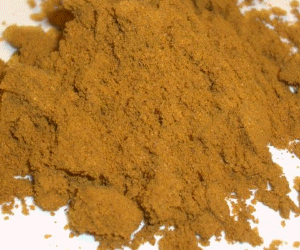SPICES & COOKING (Featuring Curry)
September 21, 2007 4:34:00 PM EDT

If you visit 15 to 20 different restaurants on any given day, and order the same dish, for example, oxtail, at each restaurant, that dish will taste different, the reason, the seasonings and spices used to flavor that dish. Every day we flavor our foods with spices, herbs and condiments, and depending on the one’s we use or do not use, and the quantity, our foods will ether be a “Hit”! or “Miss”!
Condiments are used to enhance the flavor of foods, spices gives food zest or relish and herbs do both, with an added value, medicinal benefits.
Although there is no distinct difference between a herb and a spice, (they are from the same family), their use and purpose though similar, differ in varying degrees, depending on that particular herb or spice. For example, certain spices are useful for their aromatic properties, while some herbs are generally applied for treatment of certain types of ailments.
Some of the most common spices used every day for cooking includes, black pepper, clove, ginger, mace, nutmeg, paprika, star anise, tumeric and vanilla.
Curry powder, one of the most common condiments used in 99% of all Caribbean-American restaurants value some attention at this point, for although not categorized strictly as a spice, curry is really a blend of as many as 16 to 20 different spices, including cinnamon, clove, cumin, fergungreek, ginger, red and black pepper and tumeric, which gives curry its characteristic gold/yellowish color or hue.
Curry is native to India, there, the fresh leaves are used in cooking, the dried leaves resemble bay leaves and are the only ones available in the U.S. One table spoon of curry can provide anywhere from 0.3 grams to 1.86 milligrams of protein, fat, carbohydrates, calcium, iron, IU vitamin A and C.
Corriander, an agent that relives intestinal gas is the main ingredient in most curry powders. Other ingredients in curry can increase the liver’s output of bile, increasing perspiration, as well as irritate the skin and mucous membrane, although, this can be beneficial in helping individuals to cough up mucous.
Many Caribbean-American Restaurants serve curry dishes daily, and several of these restaurants some of which are owned and operated by Caribbean-Americans of East Indian extraction, prepare many of the traditional dishes using a curry base.
Tumeric, which gives curry its characteristic yellow hue is a member of the ginger family, which simply means, that like the ginger plant, tumeric grows similarly, with thick rhizomes or underground stems. It is native to India, China and the East Indies and the underground stems are grounded to make a yellow powder which is then used as a flavoring and to color a wide variety of foods, including butter, cheese, margarine, fruit drinks, liqueurs, and of course, curry powders, mustard and mustard pickles.
The pigment in tumeric is curcumin also known as “Tumeric Yellow”, which was once used as a fabric dye, until it was replaced with synthetic colors. It taste slightly bitter, with a peppery flavor and aroma. Tumeric stimulates the liver to increase its production of bile, the greenish yellow alkaline fluid secreted by the liver that helps to emulsify fats, it also stimulates the gall bladder and biliary duct to discharge bile and increase excretion of cholesterol. Individuals with gall bladder or liver diseases should be very careful when using spices like tumeric or herbs like peppermint or ginger which stimulates the biliary duct.
Curcumin’s color is very sensitive to light, tumeric should therefore be stored in a cool, dark cabinet, and because it is very strong, it is advised that you use tumeric sparingly.
As with almost any product, too much of it can affect you adversely. Curry certainly helps to spice up your dishes, and Roti without curry, is almost like Baseball without hot dogs, however, care should be applied when using curry to ensure it is not misused.
Posted in News By Karl M. McGowan
